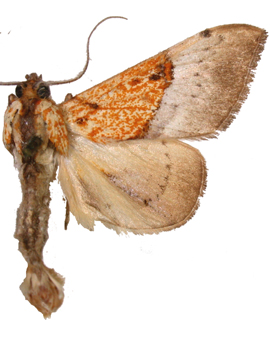Agrotera magnificalis Hampson, [1893]; PED 11

-
Taxonomy
Agrotera magnificalis Hampson 1893: 173-174, (Plate CLXXIV. fig. 17. TL Sumbawa.
It is said to be junior subjective syn. of Sagariphora heliochlaena Meyrick1894: 461 but this needs to be verified.
A. scissalis, A. heliochlaena and A. magnificalis are distinct from other Agrotera spp and may prove not to be congeneric with the A. basinotata group. -
Description
Wing length : 11mm. This is a very distinctive Agrotera sp. having broad wings with a broad orange basal area and steel blue distal parts. The males have prominent valvae and associated fulvous scale pencils. Its wingspan can range up to 28mm. It is similar to A. heliochlaena Meyrick, 1894 (illustrated in RTS 1994), which has a slightly different wing shape and said to have curled tufts on its hind tibia unlike magnificalis (RTS: 183-4). Agrotera scissalis Walker ([1866] 1865) is similar but that species lacks any orange at the HW base. The erebid (Herminiinae) Acidon semiochrea Holloway, 2008 has superficially similar FW fascies and colouration but can be easily distinguished by its long recurved labial palpi.
-
Distribution & Habitat
Sri Lanka, Burma, W. Malaysia, Sabah, Java, Sumbawa, Bali. Lowland and lower montane; <1500m.
-
Life History & Pest Status
no content available.
-
Similar spp.
Agrotera heliochlaena
Agrotera scissalis
-
Unrelated Look-alike
Acidon semiochrea (Erebidae: Herminiinae)
-
References
Hampson, G. F. (1893) The Macrolepidoptera Heterocera of Ceylon. Ill. typ. spec. Lepid. Heteroc. coll. B.M., 9. 182 pp., pl. 157-176. London.
RTS (1994): 183-4, pl. 30, fig. 17.
Meyrick, E. (1894) XVIII On Pyralidina from the Malay Archipelago, Trans. Ent. Soc. Lond. 1894: 455-480. -
Genitalia
no content available.
-
DNA Barcode
no content available.
-
3D Imaging
no content available.
-
Spare
no content available.
KEY TO TABS
(1) Taxonomy, (2) Description, (3) Distribution & Habitat, (4) Life History & Pest Status, (5) Similar spp., (6) Unrelated Look-alikes, (7) References, (8) Genitalia, (9) DNA Barcode, (10) 3D Imaging, (11) Spare

